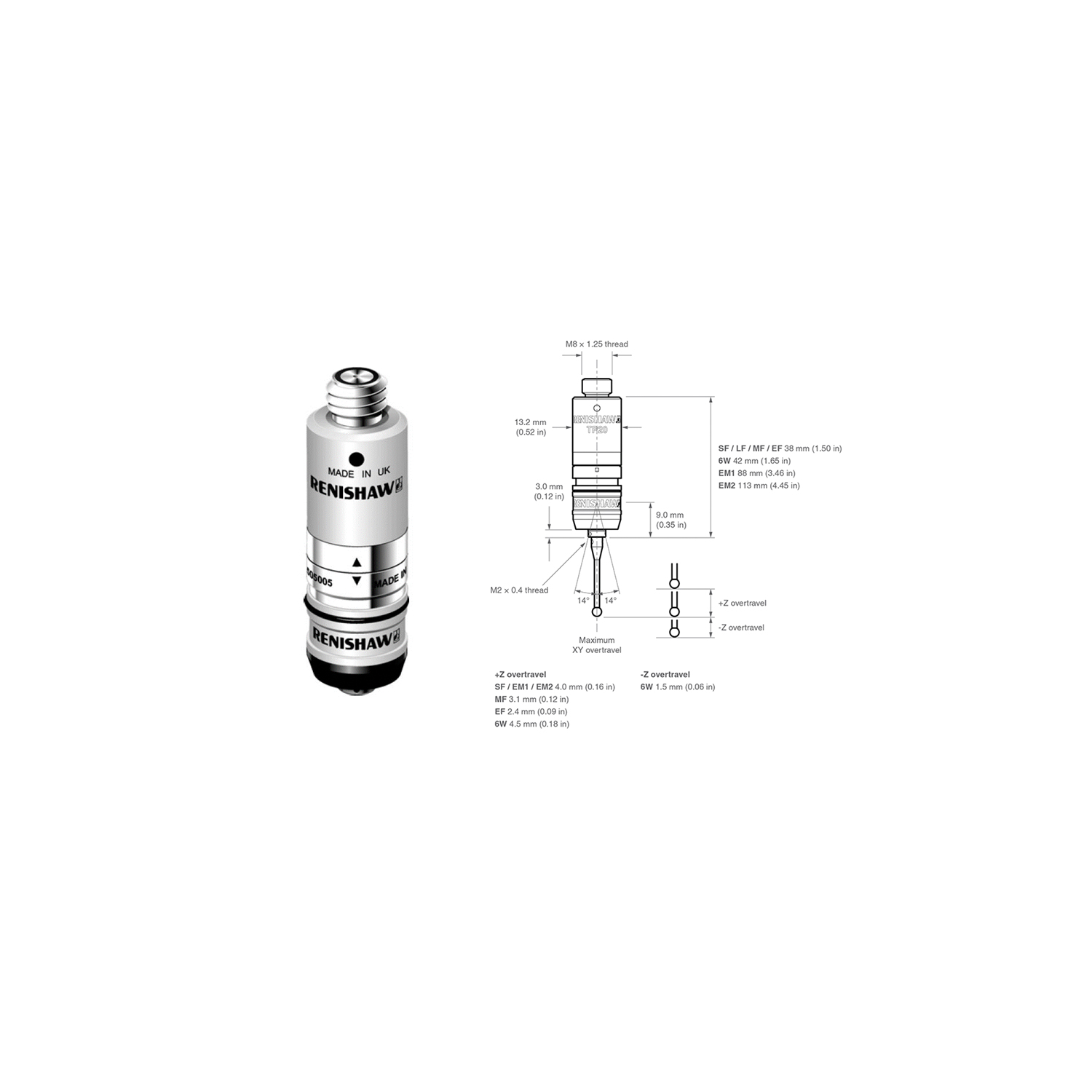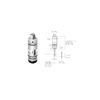The system components are:
• TP20/TP20 NI probe body
• TP20 stylus module – seven module variants allow for optimization of performance to suit the application
• MCR20 module changing rack – automatic operation
The TP20 probe system may be used with Renishaw’s PI 4-2, PI 7-2 or PI 200 probe interfaces.
TP20 probe body
The TP20 probe body houses one half of the highly repeatable magnetic kinematic coupling that attaches the stylus module and body. The body also contains a magnetic proximity switch to inhibit triggering of the probe during automatic module changing with MCR20.
Note: If the probe is operated close to magnetized parts/clamping etc, the probe trigger may become inhibited. Countermeasures include the use of long styli, stylus extensions or body orientation to increase the distance to the magnetic source. Alternatively, use the TP20 NI probe body.
TP20 NI probe body
The TP20 NI probe differs from the TP20 body in that it is not affected by magnetic fields. However the probe trigger must be inhibited through software during change cycles using the MCR20.
Specification
| Principal application | DCC and manual CMMs suitable for most applications. TP20NI is for operation within a magnetic field. |
| Sense directions | |
| All modules except 6W | 5-axis: ±X, ±Y, +Z |
| 6W | 6-axis: ±X, ±Y, ±Z |
| Pre-travel variation: | |
| LF | ±0.60 μm (±0.000023 in) |
| SF / EM1 / EM2 | ±0.80 μm (±0.000032 in) |
| MF | ±1 μm (±0.000039 in) |
| EF | ±2 μm (±0.000079 in) |
| 6W | ±1.50 μm (±0.000058 in) |
| Unidirectional repeatability (2σ μm) (at stylus tip): | |
| SF / LF / EM1 / EM2 | ±0.35 μm (±0.000014 in) |
| MF | ±0.50 μm (±0.000020 in) |
| EF | ±0.65 μm (±0.000026 in) |
| 6W | ±0.80 μm (±0.000032 in) |
| Repeatability of stylus change (maximum): | |
| With MCR20 | ±0.50 μm (±0.000020 in) |
| Manual | ±1 μm (±0.000040 in) |
| Stylus range | M2 |
| Mounting method | M8 thread |
| Suitable interface | PI 7-3, PI 200-3, UCC2-2 |
| Stylus module changing rack | |
| Automatic | MCR20 |
| Manual | MSR1 |
The above data applies for test conditions as follows: Stylus length 10 mm (0.39 in); stylus velocity 480 mm/min (1.57 ft/min)
Probe modules
A range of seven, application specific, probe modules is available and are identified by coloured caps.
| Module | Application | Trigger forces* |
| SF- Standard force | Suited to the majority of applications | XY: 0.08 N |
| Z: 0.75 N | ||
| Stylus: 10 mm | ||
| LF- Low force | Low trigger forces applications – e.g. rubber seals | XY: 0.055 N |
| Z: 0.65 N | ||
| Stylus: 10 mm | ||
| MF- Medium force | Where a higher trigger force than standard is required | XY: 0.1 N |
| Z: 1.9 N | ||
| Stylus: 25 mm | ||
| EF- Extended force | Large stylus assemblies or where vibration causes spurious ‘air’ triggers | XY: 0.1 N |
| Z: 3.2N | ||
| Stylus: 50 mm | ||
| 6W- 6-way | Measurement in the –Z direction – e.g. undercuts | XY: 0.14 N |
| Z: 1.6N | ||
| Stylus: 10 mm | ||
| EM1 STD- 50 mm extension | Majority of applications requiring a 50 mm extension | XY: 0.08 N |
| Z: 0.75 N | ||
| Stylus: 10 mm | ||
| EM2 STD- 75 mm extension | Majority of applications requiring a 75 mm extension | XY: 0.08 N |
| Z: 0.75 N | ||
| Stylus: 10 mm |
* low force direction
Above data applies for test conditions as follows: Stylus length as stated above. Stylus velocity 480 mm/min (1.57 ft/min).
TP20 probe kit 1
The TP20 is a compact module changing touch-trigger probe. The two-piece design, comprising of a probe body and detachable stylus module(s), allows the use of a range of stylus configurations and extensions to access features on complex parts. Modules can be changed manually or automatically without the need for requalification of the stylus tip.
The standard force probe module, identified by a black cap, is suited to the majority of applications requiring extensions up to 50 mm long. The standard force probe module can be used with the following range of styli:
• Straight styli up to 50 mm long
• Star and cranked styli up to 20 mm offset
Includes two standard force modules.




